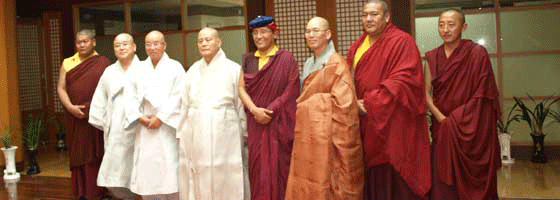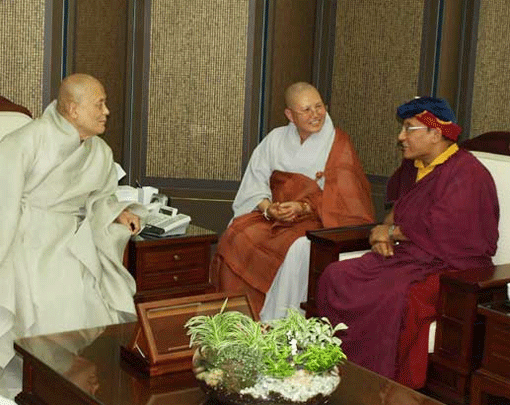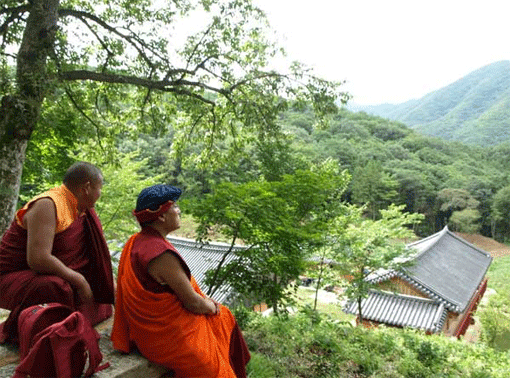One Big Family

Today, I had the good fortune to meet the head of the Jogye order of Korean Buddhism, the Most Venerable Ji Kwan, in the reception room of the Museum of Culture and History of Korean Buddhism. We had a very nice time together and spent over 30 minutes laughing and exchanging notes about our traditions. The meeting was only going to be 10 minutes, but apparently the great master himself was so happy to be able to share his knowledge with me that the meeting took much longer than what we had earlier planned.
I had a great opportunity telling him about our Pel Drukpa Lineage and he was especially interested in knowing more about it. In the discussion, we discussed a bit about the lineage of Bhikshuni or the full ordination of nuns and I told him that we don’t have this lineage in Tibetan Buddhism, and that I was truly admiring the ability of Korean Buddhism being able to keep this Bhikshuni lineage very firmly. He kept telling me that I should continue to work to help the people in this world in the name of compassion and love. I replied that we all should be doing this together. In fact, we are one big family, the only thing is that due to a lack in communication, Tibetan Buddhists do not know much about Korean Buddhism and Korean Buddhists do not have complete knowledge of Tibetan Buddhism. In fact, most Koreans only know a very small portion of Tibetan Buddhism, and for us, we know nothing about Korean Buddhism. So we both feel that the key point is that we need to be actively exchanging our knowledge and to improve the relationship and understanding between different Buddhist traditions of different cultures and different countries. The great master Ji Kwan seemed to agree that this is a paralysed part of our relationship.
The great master gave me the Prajna Paramita written on black stone with gold paints, and also a few other gift items. I was very moved to receive the Prajna Paramita from him because this is the heart essence of Lord Buddha’s teachings and I also came to know that the Heart Sutra is the main practice of Korean Buddhist tradition. Anyhow, I had received lots of gifts from everywhere this time, but this Prajna Paramita from the great master Ji Kwan is the one that I consider to be most precious for me and my lineage. He had invited me to visit him again so that we can talk more. I will definitely keep his invitation in my mind and in my heart. I want to thank all my friends in South Korea for arranging this auspicious gathering. We both felt like two very old friends meeting again. I want to especially thank Master Deokjo, on behalf of the Pel Drukpa Lineage and our followers, for arranging this meeting, because it is definitely an important beginning for us to know more about Jogye order and for them to know more about the Drukpa Lineage.
I think by now many of my friends and students must be wondering what is Jogye lineage, how important it is in Korean Buddhism. Jogye order is the largest Buddhist sect that manages 2,000 temples, with 15,000 monks and nuns and around 8 million followers. Their official English website is www.koreanbuddhism.net and I think those of you who want to know more can find out many things about Jogye and their Zen practice.

The great master Ji Kwan also asked me about the different colours of hats that are worn by the masters of different Tibetan Buddhist schools. He was making a big fuss about yellow hat, red hat and black hat and he asked if there was anyone wearing white hat. I laughed and said, “Why not?” I pointed to my hat and said, “I am wearing blue hat.” And he laughed. I explained to him that most of these different colours of hats, different stories and funny gossips were created by foreign media and the book writers who could be taking biased information or misleading information from whatever sources they chose to believe in and there are a lot of fabrications and manipulations. These people didn’t know about the significance of the hats and the inner realisation of the different lineages. So they could only tell by the external appearances, calling the different schools by colours of hats, such as Yellow Hat School, Red Hat School, which I read a number of times even in famous travel books printed by Lonely Planet and others, some even have our lineage’s name spelled wrongly as “Brukpa” and for some strange reasons, everyone is quoting this book and that book and this writer and that writer, without asking us the people who are wearing the hats, were our lineages ever known by the colours of our hats, were our lineages ever known by the different colours of our robes, how did our names come about, etc? So some smart people misuse this wrong information to their full advantage. Sometimes I get so tired of listening to this and also tired of explaining. I had asked a group of my friends and students to write to the various websites to correct these wrong facts whenever they come across, instead I was told that they were insulted because there was no reference to books and videos and whoever outsiders giving the wrong information. This is very unfair to the different lineages and their masters. This really will result in the degeneration of Buddhist lineages. For us, it is really disrespectful to call the different sects by the colours of hats. I was very happy that the great master Ji Kwan took this information seriously.
In a way, I admire Korean Buddhist masters who recently came out with great courage to protect Buddhist traditions and teachings in Korea. I think we all should be living harmoniously as one big family, regardless of whatever religions or whatever Buddhist sects. Unfortunately sometimes to protect one’s own spiritual tradition and lineage, it’s the job of spiritual masters to bring this up and make this known to the public, because most people are generally quite naive and easily being misled by whatever they read and whatever they hear, without having a clear understanding of the full situation.
Everywhere I went in South Korea this time, I was very surprised to see that almost each of the temples has a very nice and huge assembly hall, a very well managed guesthouse, a very nice coffee shop, a souvenir shop, a beautiful Zen garden for relaxing and also a huge pond with many big and colourful fish. I never had the chance to visit the temples in South Korea very precisely. This is in fact my first time to truly visit and stay in the temples. Even though I travel a lot to many places to share my little knowledge, I normally don’t stay in a temple or a monastery. Now I came to know that almost all the Korean Buddhist temples have the similar arrangement with fish pond, very huge and old trees and all these things. This kind of beautiful environment will help meditation because external environment is very important for meditation, and since Korean Buddhist tradition emphasizes a lot in Zen meditation, this explains why the temples here have such a great atmosphere to support meditation. I was not aware that a temple can have all these facilities, therefore I was very proud to be able to transform Druk Amitabha Mountain into a meditation garden with all the above facilities like a Korean Buddhist temple, which those of you who are coming for the First ADC will get to see. Of course, Druk Amitabha Mountain is not as beautiful as any one of these Korean Buddhist temples, but it will definitely be gradually improved.

Back in Tibet, there is no tradition of having ponds, meditation garden, coffee shop and souvenir shop in a monastery. None of this was in our dreams. We think that having these facilities will make us unnecessarily busy, and since we have to practise, meditate and do pooja, all these different things, we don’t have time to have all these different facilities for our relaxation. But I can’t help not to have these in Druk Amitabha Mountain. Before I came here, I thought I had a very unique way of designing a monastic institution with fish pond, meditation garden, Japanese landscape, western coffee shop with very nice desserts and souvenir shop and also now a medical clinic. Now I realise that I am actually the biggest copy cat. I must have copied this idea from somewhere, who knows? But still egoistically speaking, I am saying to myself, “Who is the copy cat?”
I want to thank Reverend Seolo whom I met again after 24 years. I was especially happy that she could speak such fluent Tibetan and translate for me very nicely. Since she is from our Pel Drukpa Lineage which is the lineage of true meditation and the lineage of genuine yogis, meeting her again is one of the highlights of my trip this time. Her devotees, such as the local ex-mayor and his family, who are so kind and friendly, also came for lunch with us. She also invited a very prominent professor of the local Buddhist university, who is also a very important Buddhist monk, to join us for lunch.
This time, I really feel that I had visited South Korea to reconnect with my fellow brothers and sisters in another Buddhist tradition. It is full of enjoyable memories, laughter, inspirations and hopes for the continuing development and progress of our common spiritual lineage passed down from Lord Buddha. We all need to be encouraging each other, supporting each other genuinely without selfish ego to influence or convert others. Tonight, I am writing with great joy filling my entire heart about this very auspicious trip that will definitely grow to be a beneficial relationship for both of our Buddhist traditions, so that we will be able to enrich and morally support each other with knowledge, experience and skills.
– The XII Gyalwang Drukpa in South Korea




